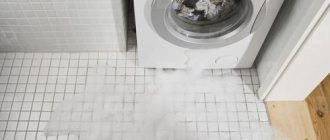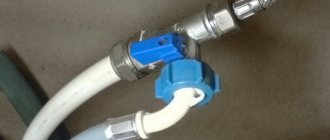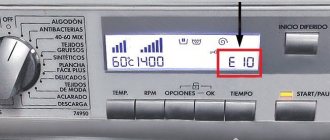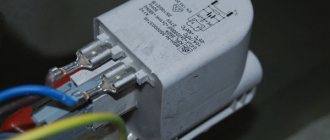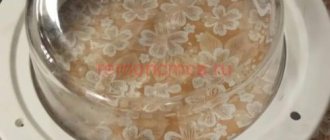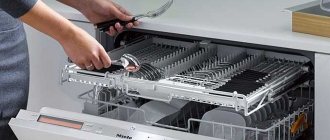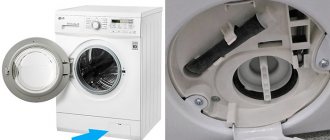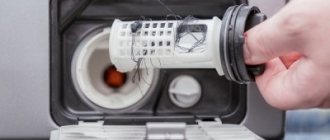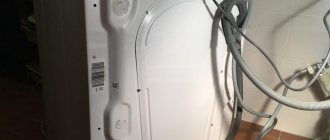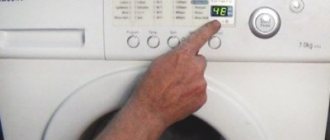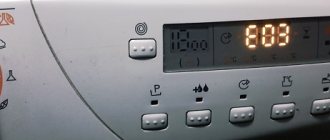The last stage of connecting to the water supply is installing the washing machine inlet hose
Today we have to figure out how to connect a washing machine to the water supply. We will get acquainted with several solutions of varying complexity, differing in the ease of operation of the automatic machine and the fittings involved. In addition to water supply, methods of draining water from draining the machine into the sewer will be discussed. Let's get started!
Given
First, let's formulate the terms of reference as clearly as possible:
- Modern washing machines are connected only to cold water supply. The water is heated to the required temperature by its own heating element;
- The thread diameter of the inlet hose is DN 20. To connect it, you will need an external thread of the same size;
The photo shows the inlet hose. The size of the attached threads is 3/4 inch, or DN 20
- A hermetically sealed solenoid valve is responsible for drawing water from the water supply system. Accordingly, turning off the water with a separate tap is necessary (for example, in case of going on vacation - it will serve as additional insurance against flooding of neighbors), but the corresponding element of the shut-off valve will be used infrequently;
- The automatic machine is installed at a minimum distance from the water supply and sewage system. Its typical location is a bathroom (or a combined bathroom), a kitchen, or a storage room located near the bathroom.
Can you see everyone?
Here is a brief description of all the connection diagrams that we are going to introduce the reader to:
| Image | Description |
| The water tap is installed between the cams (eccentrics) and the corners or water sockets under the faucet in the bathroom. For hot water, a chrome extension is mounted, the same length as the faucet. The advantage of the scheme is the convenient and accessible location of the tap, the disadvantage is that the mixer extends 8-10 cm from the wall. |
| The tap is screwed into the thread on the rigid cold water supply in front of the flexible hose, which is responsible for connecting the on-board faucet or toilet flush cistern. The union nut of the flexible connection is connected to the external thread of the faucet. Advantages: the tap solves the problem of sealing a flexible connection with an uneven edge of a steel thread; The connection node is in most cases hidden from the view of the visitor to the room and does not spoil its design. Disadvantage: inconvenient access to the tap |
| The connection is made with clamps to a smooth steel pipe at any convenient water supply point in the apartment or even directly to the riser to the valve at the entrance to the apartment. Advantage: arbitrary location of the tap, not tied to a threaded connection. Disadvantage: violation of the integrity of the water supply system. After turning off the washing machine, the clamps will remain on the pipes. |
Method 1: connection in front of the mixer
What do you need to connect the washing machine in front of the faucet in the bathroom with your own hands?
Materials
This:
- Connection tap (three-way, with 1/2" male and female threads and one 3/4" male thread). It is better to prefer a ball valve (rotating 90 degrees) with a long flag: it is more reliable than a screw valve and does not require significant effort to open/close. It is advisable that the external thread of size 1/2 ends with a flange: it will simplify the sealing of the threaded connection;
An ideal three-way valve in every way
- Chrome plated thread extension (1/2 inch male and female threaded pipe) with a length equal to the length of the faucet;
Chrome 1/2" Thread Extension
- The sealing material for threads is thread sealant or plumbing flax impregnated (for example, silicone sealant).
Reference: linen impregnated with silicone or organic solvent paint does not rot during prolonged contact with water and does not fade at high operating temperatures. To avoid getting your hands dirty when winding flax, apply a little sealant to the thread, apply three or four turns of winding and lubricate its surface with a thin layer of silicone. When tightening the thread, the winding will be evenly saturated throughout the entire volume.
Sealing a threaded connection: first apply sealant to the threads, then wrap flax
Installation
Here are step-by-step instructions for connecting:
- Close the cold water and hot water valves at the entrance to the apartment;
- Open the taps to make sure the valves are working properly and the water is completely turned off;
- Unscrew the union nuts of the mixer with an open-end or adjustable wrench and remove it;
- Unscrew the eccentrics from the corners or sockets;
The first stage is dismantling the mixer
Hint: to unscrew the eccentric, insert a sponge of pliers or any other suitable object into it. The eccentrics are equipped with an internal cut that allows them to be screwed in and out without damaging the decorative coating on the outer surface.
- Wind up the external threads of the faucet and extension and screw them into the corners or water sockets;
- Rewind and screw the eccentrics into the internal threads of the faucet and extension;
- Reinstall the faucet;
Tip: when installing, it is better to replace the old gaskets under the mixer union nuts with new ones. Rubber loses its elasticity over time due to liming, and the joints may leak after assembly.
The best gaskets are silicone. They combine elasticity with a long service life
- Turn on the water and make sure there are no leaks;
- Connect the washing machine with a standard inlet hose to the tap and start washing.
Washing machine inlet hose
- Kinds
- Inlet hose with protection (aquastop)
- Specifications
- What length is most popular?
- Correct location
- How to connect?
- Why does it leak: common causes of leaks
- Replacing the inlet hose
Water is added to the washing machine through a special inlet hose. It is with its help that the connection to the water supply occurs. The problem is that it can cause water spills. This could be due to various reasons:
- The compression sleeve is poorly compressed,
- The upper layers of the hose burst;
- The hose is not long enough
And, although most often it comes complete with a washing machine, such situations are not uncommon. Let's pay attention to these aspects to avoid unpleasant situations.
Kinds
Types of inlet hoses:
- With fixed length. They are a pipe from 1 to 5 meters in length;
- In the bay. The length reaches 10 meters;
- Telescopic. Thanks to the corrugated wave, the length can be increased by stretching;
- With Aqua-stop system. A system to avoid leaks.
Inlet hose with protection (aquastop)
We will pay special attention to this system. It allows you to further protect both your property and your neighbors’ apartments from flooding.
When water is supplied to the hose, high pressure is applied and to withstand it, the hose has a double wall. It can withstand pressure up to 70 bar. But, even if the hose breaks, water flows into the knob, which is filled with powder. When wet, it expands and blocks further water flow. Often a solenoid valve is added to such a system. In this case, the flow of water is blocked by the valve.
There are models that have an automatic pump built into them. He starts pumping water if the valve does not work. But, after such an emergency, the hose becomes unsuitable for further use . It cannot be reused.
Specifications
Let's look at several hoses, both domestic and imported.
1. Cotali UDI-BLACK (Italy).
- Length - 2 meters
- Permissible temperature 1000 degrees,
- Capable of withstanding pressure up to 80 bar,
- Capacity 42 liters per minute.
2. Electrolux (Sweden).
- Length – 1.5 meters
- Permissible temperature 900 degrees,
- Capable of withstanding pressure of 60 Bar,
- Equipped with the Aqua-stop system.
3. Uglich polymer plant (Russia).
- Permissible temperature 900 degrees,
- Compatible with all famous foreign brands,
- Withstands pressure up to 200 Bar,
Inlet hose Cotali UDI-BLACK (Italy)
Electrolux inlet hose (Sweden)
Inlet hose Uglich polymer plant (Russia)
What length is most popular?
There is one important nuance: it is not recommended to make the distance to the drain more than 15 meters. The most commonly used inlet hoses are 3 to 5 meters long.
Check all hole diameters, seals, nuts and other fittings. It is better to purchase a hose from the same company as the washing machine. And if this is not possible, then you need to select a hose that is as close as possible in characteristics.
Correct location
A proper installation does not have any special features, the main thing is to avoid kinks and not allow the hose after the tap to go straight to the top.
How to connect?
The hose has a thread that corresponds to the standard size - three quarters of an inch. With its help, it is connected to the shut-off valve. New houses already have such a place. If the house is old and the project does not plan a place to place the washing machine, then the hose is connected to the pipe to the faucet in the bathroom.
To connect the washing machine inlet hose to the hot water pipe yourself, watch the video.
Why does it leak: common causes of leaks
The most common problem that causes a leak is a weak connection to the pipe or washer; cases of simple aging and wear of the rubber gasket are not uncommon. The only correct solution is to replace this gasket.
Another possible reason could be that the hose is not in the correct position: it may be twisted or kinked. Place the hose in a natural position.
Replacing the inlet hose
A leak can also be caused by wear and tear on the hose itself. This can happen due to mechanical stress or rubbing of the tube at the connection point. The replacement procedure itself is not such a difficult undertaking:
- Turn off the water.
- Disconnect the damaged hose from the water supply and from the machine and install a new one in its place.
It seems that everything is very simple, but often this work leads to the need to lengthen the inlet hose. This is no longer such a simple procedure if you were unable to find a hose from the same manufacturer as the washer. Selecting the appropriate diameter gaskets and connectors can be a very troublesome task. Therefore, if you are faced with such a need, many repair shops recommend turning to professionals so as not to aggravate the problem.
The video below shows in detail how you can replace the inlet hose yourself without the help of a technician.
For the smooth operation of the washing machine, you must follow the simple rules that are written in the user manual . And in case of a breakdown, you don’t need to try to fix the problem yourself. It is better to entrust this question to the master.
- Washing machine height Standard height Will the washing machine fit under the sink? What other sizes are important when choosing? Not many people who…
- Service life of the washing machine Requirements according to GOST Manufacturer's data What happens in practice? What factors affect service life?...
- Socket for a washing machine in the bathroom Requirements Calculation of cable cross-section What height is optimal? How to install? Safety criteria When installing a washing machine in…
- Washing machine power consumption What is energy used for? Consumption by class Factors How to determine power? How to save money? Washing power…
Method 2: connection before the flexible connection
This connection option is even simpler than the previous one. What does it need?
Materials
This:
- Faucet for washing machine . All requirements are the same as when installing it under a bathroom faucet, with the exception of the collar after the external thread: in this case it is not needed;
- Rewinding for threaded connections;
Easy to use and durable winding - Tangit Unilok thread
- Gasket for the union nut of the flexible hose or a new hose with the same length as the old one.
Reference: the trouble-free service life of flexible hoses in stainless steel braiding does not exceed 5 years. If the service life of the hoses is approaching five years, do not be lazy to replace them with new ones, without waiting for a break and flooding of the apartment.
The average service life of such eyeliner is 5 years. During this time, the rubber core loses its elasticity, so after dismantling and reinstallation the hose often leaks
Installation
Connecting the water supply to the washing machine is carried out in the following order:
- Turn off the cold water and make sure that it stops flowing to the site of the upcoming work;
- Unscrew the union nut of the flexible connection;
- Wind the thread underneath;
- Install a three-way valve;
- Replace the gasket under the union nut of the flexible hose or the entire hose;
- Connect the flexible connection and inlet hose of the washing machine;
- Turn on the water and check all pressure connections;
- Wash it.
Aqua-stop systems for flexible inlet hoses
Such systems protect washing machines from leaks. All washing machines according to the degree of protection are conventionally divided into three types: defenseless, partially protected and completely protected from leaks. One of the varieties of the Aqua-Stop partial leakage protection system is a valve that is installed between the supply tap and the inlet hose. Its operating principle is to determine the pressure difference. If it is completely torn off, then such a valve will immediately work if the flow rate of the outgoing stream exceeds 10-13 l/min. If the seal was broken and it was simply cracked, then such a valve will not work.
There are Aqua-Stop hoses that partially protect washing machines from leaks or large amounts of water. Its design feature is a high-pressure hose, which is built into the main inlet hose. If it breaks or its aluminum extrusion weakens, the water will reach the block in which the absorbent is located. After water enters, the absorbent will expand. This will cause the fuse to move under the influence of the expansion of the absorbent, which will close the water supply valve. If your washing machines do not have any protection against leaks, then using such systems will help you avoid this. The only drawback is that if it breaks, you will need to completely change it.
Let's consider the last type of leakage protection, which uses an electromagnetic valve with a float on the pan (Aqua-stop). Such protection against grooves is called complete. In this case, the inlet hose does not contain absorbent, but an adjusted solenoid valve, which has a special drain program built into it. When you need to pump water, voltage is applied to the valve, it opens and water flows to the washing machine. When the water has filled up, this valve closes and the machine continues the program wash. If it has been partially damaged and liquid leaks out, then through the internal drainage system the water enters the pan, which is equipped with a special float. When the liquid in the pan reaches a certain level, the float closes contacts that close all solenoid valves. Such a system guarantees complete protection against leaks, even if water leaks from the washing machine itself.
The inlet hose breaks quite rarely. However, if this does happen, then such systems will help avoid negative consequences. It can also be extended if necessary.
Inlet hoses with Aquastop system
Method 3: connecting to a direct section of water supply
The last scenario is inserting a tap into a straight section of water supply.
Materials
Required:
- Clamp with internal thread size 1/2 inch (DN 15);
Brass clamps for inserting into steel water pipes
- Ball valve with male-female threads;
Ball valve with external and internal threads
- Adapter from DN 15 thread to DN 20 thread.
Captain Obvious suggests: the adapter must have two external threads. One is screwed into the ball valve, and the union nut of the inlet hose is screwed onto the second.
Brass Pipe Thread Adapter
- Sealing material for threads.
Installation
- Turn off the cold water;
- We drill a hole with a diameter of 8-10 mm in the HVS liner;
- We clean the surface of the pipe around the hole from paint and rust;
- Install and tighten the clamp;
Tip: if the clamp does not include a rubber gasket, cut it from an old car inner tube.
- We sequentially install the ball valve and adapter, tightening the threaded connections;
- We connect the machine with the inlet hose;
- We check connections under pressure.
A special case
What to do if for some reason you cannot turn off the water (the valve on the supply line is faulty, the tap needs to be embedded in the riser, etc.)? This scenario differs from the scenario described above only in the sequence of actions and a specific tool.
- Mount a clamp on the pipe that has been cleaned of paint and rust and install a ball valve on it;
To clean the pipe, it is most convenient to use a drill with a wire brush.
- Open the faucet and drill the pipe directly through its valve;
- As soon as the wall of the supply or riser is drilled, remove the drill and turn off the tap. Further actions are no different from those described above.
Scheme of tapping into a water supply system under pressure
Important: in this case, you can drill the pipe only with a hand tool - a hand drill or a brace. A water-filled electric drill combined with a puddle on the floor will turn into a type of portable electric chair.
For work under pressure, use only hand tools
Sewerage
Water drainage can be arranged:
- In a rented apartment - in the sink or bathtub. The plumbing fixture will be unsuitable for use for its intended purpose for no more than an hour and a half a day. As a bonus, you will receive a guaranteed absence of sewer blockages: hot water with powder perfectly washes away fat from the walls of sewer pipes, which is the main cause of blockages;
Not easy, but very simple: the drain is directed into the kitchen sink
- If you have a plastic prefabricated sewer comb installed in your apartment (intra-apartment sewerage distribution) - into the tee installed in its gap. Preferably - oblique, with a drain directed in the direction of movement of the drains. In this case, a volley discharge of water (for example, from a bathtub) and its simultaneous drainage by a washing machine will not lead to overflowing of the pipes;
Connecting the drain to the oblique tee
- Owners of cast iron sewers should take a closer look at siphons for sinks with an outlet for connecting the drain hose.
Connecting the drain to the siphon
The general rule is that the connection of the drain hose to the sewer must be sealed. Sealing is carried out with standard rubber cuffs or any available material (adhesive tape, polyethylene foam, etc.). Through leaky connections, fumes from sewer drains and risers will enter your apartment, and they will not smell like roses.
Sealing the connection between the drain and the sewer with a rubber cuff
Popular manufacturers and prices
The set of inlet hoses for washing machines is selected by the manufacturer. The brand of hose that is included in the kit depends on the type of washing machine. The quality of the washing machine is proportional to the quality of the inlet hose. Let's look at the most popular options.
| Manufacturer's name | Technical features | Footage / cost |
| Electrolux | · Equipped with Aqua-stop system; · Maximum permissible temperature 900 C; · Withstands pressure up to 90 Bar. | 1.5 m – 800 rubles |
| Reflex | · Double-layer tube; · Additional protection against leaks; · Withstands pressure up to 20 Bar; · Equipped with nuts that prevent the hose from unwinding; · Maximum permissible temperature 250 C. | 1.5 m – 150 rubles |
| Scanpart | · Withstands pressure up to 90 Bar; · Used as an inlet hose. | 2.5 m – 900 rubles |
| CODO | ·Metal base; · Equipped with an additional metal sleeve. | 1.5 m – 160 rubles |
| Cotali UDI-Black | · Maximum permissible temperature 1000 C; · Withstands pressure up to 80 Bar; · Working capacity of water transmission 43 liters per minute. | 2 m - 360 rubles |
It's impossible to say which model is better. We only point out that each is selected based on a specific case. For example, if you have high pressure in the system, then you need to choose an inlet hose that can withstand it. Also, if you want to protect yourself from leaks, then choose Aqua-Stop hoses. If you feel that the hose is about to break, then it needs to be urgently changed and, if necessary, extended.
Filler hose, reinforced
To all these types of water supply networks, the inlet hoses are connected in almost the same way. The only difference is the design and the different material options used. If necessary, the hose can be extended.
